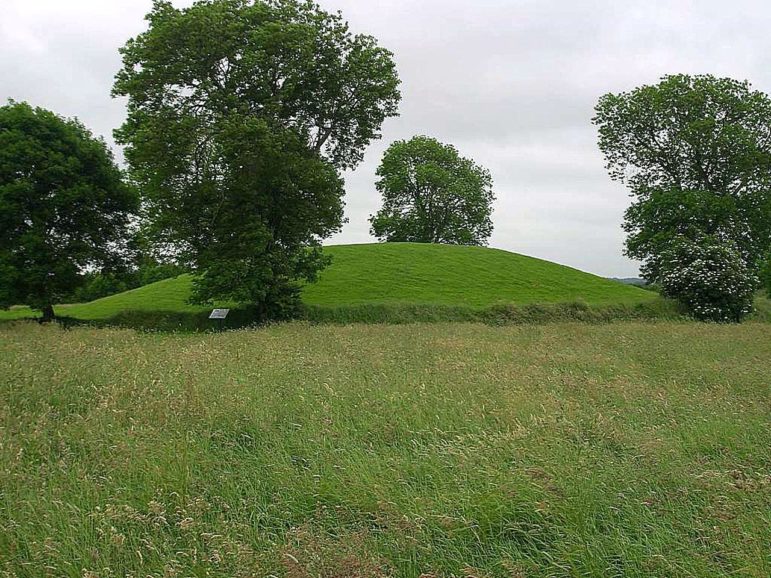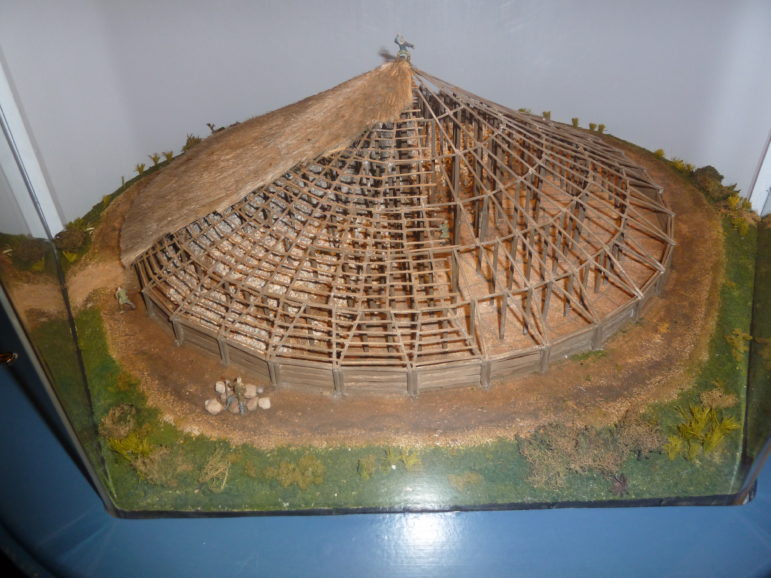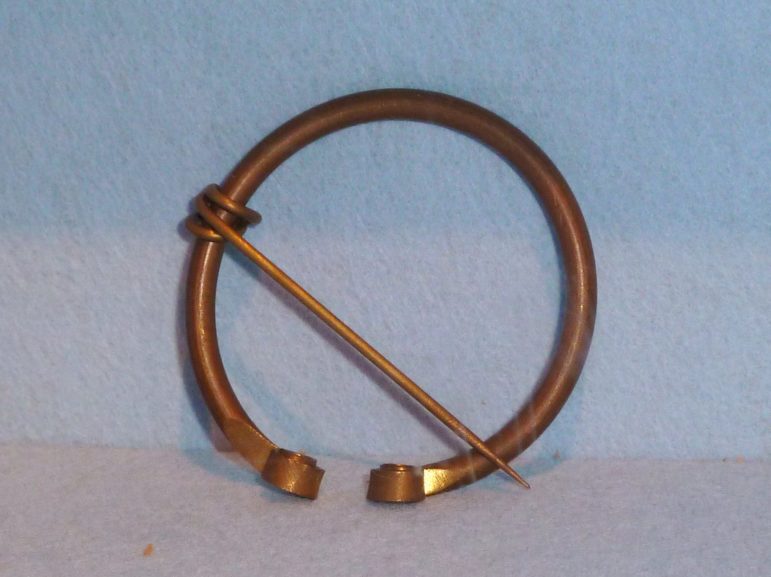TWH – Emain Macha or Navan Fort occupies a central role in the Ulster Cycle of Pagan Irish myth. The article Re-Imagining Navan Fort: New Light on the Evolution of a Major Ceremonial Centre in Northern Europe reports on recent non-invasive surveys of that site.

Emain Macha/Naval Fort – Image credit: Jon Sullivan, Public Domain,
In the article, James O’Driscoll reported on the continued and changing use of the site from the Bronze Age to the Early Medieval period. He argues that this site functioned as a ceremonial complex and site of ritual activity throughout that period. This challenges prior archaeological beliefs about that site.
Before this study, the archaeological record held that activity at Emain Macha ceased after 100 B.C.E. Soon after, people abandoned the site. Around 800 C.E, the site became the secular royal center of Ulster.
Today, visitors to Emain Macha/Navan Fort see two structures atop the monument. They see a large ring-ditch, surrounding a raised area in its center, known as Site A. They will also see a large mound known as Site B.
Site A
The banks of a massive earthwork enclose Site A. Those banks have a width of 13 m (42.7 ft) and, in some places, a height of 3 m (9.8 ft). Site A has an area of 6.3 ha (15.6 acres). Archaeologists have dated Site A to around 100 B.C.E.
Site A also has earlier structures, underneath the visible ring-ditch. Archaeologists have identified two phases of construction for these underground structures.
In its more recent phase, a double-walled wooded structure with a 16 m (52.4 ft) diameter lay below the center of the ring. It had a central post, possibly a roof support. Two burials flanked each side of its entrance on its east.
In its earlier phase, archaeologists found structures with a distinctive shape. A larger circular structure lay to the north. That circular structure abuts a much smaller circular structure to its south. In Irish archaeology, this common shape is called a figure-of-8 structure. Palisades enclosed each structure. Those palisades have radiocarbon dates ranging from 400 B.C.E. to 26 C.E.
Archaeologists found nearby, a fifth to sixth-century weaving comb and a brooch terminal. They also found animal bones from the fourth to seventh centuries. These findings indicate activity during the early Medieval period.
Site B
Site B has a height of 6.5 m (21.3 ft) and a diameter of 60 m (196.9 ft).
Excavations and surveys revealed many structures underground. One of these structures had a diameter of 40 m (131.2 ft). This roofed wooden building took up almost two-thirds of the mound area. Soon after its construction, people filled it with limestone boulders. Then, they set it on fire. After the burning, they encased it in soil, creating the mound. This strongly suggests ritual activity.
According to O’Driscoll, this burning marked the final phase of activities that had begun in the later Bronze Age. Under the remains of the burned structure, archaeologists have found four earlier structures. Triple ringed palisades formed the boundaries of all four structures. All four had figure-of-8 shapes. People had built these four structures from 991 to 590 B.C.E. Within one figure-of-8 structure, someone had buried the skull of a Barbary macaque.

Reconstruction of the Iron age building at Navan, Co. Armagh, Ireland. Image credit: Notafly – CC BY-SA 3.0,
The recent surveys of Emain Macha/Navan Fort revealed several rectangular structures. According to O’Driscoll, rectangular buildings were rare in Ireland before the ninth century. This would support the use of the site during the early Medieval period.
The other secular royal capitals of Ireland also served as Pagan ceremonial complexes, as did other sites in northern Europe. O’Driscoll sees places like Emain Macha/Navan Fort as places where “cult practices formed the basis of emergent new forms of early medieval rulership, albeit within a landscape redolent with ritual and elite imperatives from much earlier.”
Possible links to Irish myth
O’Driscoll did not link his findings to known myths, but links may exist. The Barbary macaques currently have a range limited to Gibraltar and North Africa. Someone would have to have brought that skull to Ireland, through migration, raiding, or trade.
In The Book of Invasions, the Milesians came from Spain to Ireland and defeated the Tuath(a) Dé Danann. In Irish and Irish-American Folklore, the Black Irish are said to descend from the sailors of the Spanish Armada washed up on Irish shores. Note, in this case, “black” refers to hair color. Both stories link Ireland to Spain.
The buried skull of a Barbary macaque fails to prove that the mythic event of a Milesian defeat of the Tuath(a) Dé Danann happened. The skull, however, can add another layer to the myths linking Ireland to Spain.
The Celtic Studies Resources gives two abbreviated origin stories for Emain Macha.
One concerns a dynastic power struggle in which the men refused to let Macha. but Macha succeeded. She tracked down her last three rivals and bound them to her will and made them dig the ring-fort, known as Emain Macha/Navan Fort. In that myth, Macha takes “a golden pin from around her neck” to mark out the lines of the fort. “Emain Macha is named for the gold pin about the neck [muin] of Macha.”

Iron Age pin – Image credit: Notafly – CC BY-SA 3.0
The other origin story has links to a key feature of the Ulster Cycle of Irish mythology. A strange, otherworldly woman appeared one day and began to take care of Crunncu Mac Agnomain, an Ulsterman. Eventually, she became pregnant. Among her other skills and talents, she could run really fast. Unfortunately, MacAgnomain boasted to the king about his wife’s ability to outrun the King’s prize horses. The king, then, challenged MacAgnomain under pain of death to make good on his boast.
Macha, however, was very pregnant at this time. She pled to get out of racing, but the king forced her to race. Macha won but, crying out in pain, she gave birth to twins as she crossed the finish line. In ancient Irish “emain” was the word for twins. That finish line became known as Emain Macha/Navan Fort.
Lady Gregory’s book, Cúchulainn of Muirthemne, continues this story. Suddenly everyone watching the race became as weak as Macha. She then cursed the men of Ulster. As danger approached Ulster, they would experience the pain of childbirth. The men of Ulster felt that pain when Maeve led her armies into Ulster in the “Táin Bó Cúailnge,” sometimes called the Irish “Iliad.”
Grave found of ninth Century Norse warrior and family members
Archaeologist, Astrid Kviseths, excavated ninth century graves in Vinjeøra, Norway. One body had a full set of weapons. The project manager for the excavation, Raymond Sauvage, gave Archaeology New Network background on this excavation.
Sauvage said, “The fact that he was buried with a full set of weapons tells us that this was a warrior, and in Viking times and the early Middle Ages, most warriors were free men who owned their own farms.” He went on to say that the law of that day required farmers to own their own weapons.
Live Science reported that archaeologists found 10 burial mounds containing roughly 20 graves, two mortuary houses, and two boat burials. The Wild Hunt has previously reported on those mortuary houses.
These were more familial than individual burials. The warrior’s grave and the graves of three other warriors overlapped. Sauvage said that Norse culture valued burial near the ancestors. He viewed this mixing of burials as evidence of familial relationships.
Nearby, they found cremated remains. The accompanying burial goods indicated that the deceased had been female. Most Norse graves with cremated remains only contain about 250 grams (8.8 oz) of bones. In these remains, an unusual amount of bone had survived, about 2 kg (4.4 lbs.).
According to Sauvage, the sagas report that “the bones of the ancestors were ascribed magical properties, such as giving strength and curing disease. So we can imagine that the bones might have been actively used in some kind of ritual.” In this case, however, the bones remained with the deceased.
The Wild Hunt is not responsible for links to external content.
To join a conversation on this post:
Visit our The Wild Hunt subreddit! Point your favorite browser to https://www.reddit.com/r/The_Wild_Hunt_News/, then click “JOIN”. Make sure to click the bell, too, to be notified of new articles posted to our subreddit.
